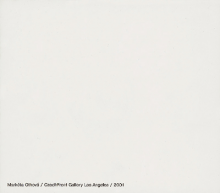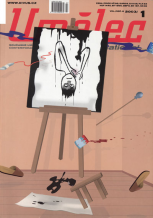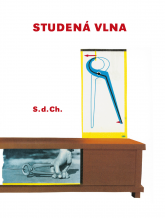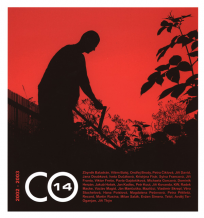| Umělec 2009/2 >> Learning From The Underground | Просмотр всех номеров | ||||||||||||
|
|||||||||||||
Learning From The UndergroundUmělec 2009/201.02.2009 Sezgin Boynik | art market | en cs de |
|||||||||||||
|
1. Learning from Attitude
The underground, although hermetic, always attempts to effectively change the mainstream world that surrounds it. We can say that its effectiveness increases proportionately to the underground’s potential to be visible in the public sphere. Actually, this is a characteristic of utopia that in part, paradoxically, disables a complete realization of the underground’s political and critical program. Therefore, if the underground wants to be effective, it should aim for the mainstream, because it might be able to disrupt or destroy the power that is concentrated there. The change that might occur in the subject of power is a rare case in the history of the underground. We cannot know for sure why this happens so rarely, but this paradox is one of the reasons why it is impossible to realize the underground’s political program. This is because every manifestation of the underground in the mainstream sphere leads to inevitable recapitulation according to the laws of recuperation. We are left with a little bit of a hope that somebody in the “mainstream world” might change their attitude, adopting a new one from the underground. We will mention perhaps the only case of this change, Patty Hearst (a.k.a. Tania) who joined the urban guerilla movement SLA after she was kidnapped. Her actions was finally attributed to Stockholm Syndrome,1 a psycho-pathologic condition. Naturally, for many, as for the unfortunate Aldo Moro, it was too late to learn anything from the underground. But it was not too late for Dejan Sretenovic, a curator of the Museum of Contemporary Arts in Belgrade, to learn something from Zampa di Leone’s hate: “Dear cultural workers, artists, colleagues, the audience and friends, I have been working intensively in culture for about 15 years, and in short – I am very SICK of it all! All those cultural policies, appointed individuals from parties, perverse institutions and preservation of positions, foundations, hamstringing… all this, my dear friends, has gone too far here, in our little Serbia! The entire Serbian cultural scene has become a somber, incestuous pile of disgusting rut that makes me so bitter that I’ve had it up to here! I don’t fear ANYONE anymore! All those Majas, Rankas, Brankas or Darkas, all those orthodox priests from Kostunica’s party, Civic Alliance, Radical Party... all those Ambrozic, Matic, Dinkic and the like... All that is now kaput, my dear friends! Yes! Capitalism is kaput! Everyone in the entire world sees by now that an end has come to capitalism and the market, and to art as a miserable product of a capitalist piece of trash! I am happy because that true punk rocker-anarchist in me from the old days has returned! And I have finally realized that museums and bureaucrats should cease living! That universities like these are a false reality and that the rich can only suck it! And I am very happy now! Because there is someone who said NO to everything!!! He exists and I completely admire him!!! Yes!!! ZAMPA DI LEONE are the only ones who are right and I invite them with this e-mail! I apologize to them, I want everyone to know and I say: YOU ARE RIGHT ABOUT EVERYTHING, ZAMPA! Because that picture that you have given us, that ugly drawing drawn as if on a toilet seat, those intrigues behind the curtains, that stupid banality… that is exactly US! Zampa, thanks again for the mirror you give us and thanks to the SEEcult that has published it entirely on the Internet. Visit the SEEcult website, need I say more: seecult.org/ipw-web/gallery/ZampaDiLeone seecult.org/ipw-web/gallery/ZampaDiLeone\?page=2 Have everyone read this, learn and try to change themselves, because what Zampa di Leone are doing really cures. This ugly mirror should be laughed at and perhaps we will all go to plastic surgery and turn over a new leaf. With the best of intentions, Yours truly, Dejan Sretenovic. Of course, this is a case of idealism, and Dejan Sretenovic still works as a curator in a museum. What is interesting in this story is the impossibility to learn from a lesson that is parodied by Zampa di Leone who position that lesson themselves as a strategy of culture jamming. Although this learning is impossible in the case of Dejan Sretenovic, there are serious protagonists of mainstream culture (for example, Marina Grznic, Tanja Ostojic, Suzana Milevska, etc, as stated in e-mails and websites) who have learned something from Zampa di Leone comics. It is a certain kind of a lesson that comes from attitude, similar to Greil Marcus’ perception of Johnny Rotten’s “rrrrrs” as revolutionary anarchy described in his punk-situationist book “Lipstick Traces.” Such a lesson paves the way for indifference by numbing any kind of radical action at the very beginning, reducing the underground’s entire criticism to some kind of “negating” attitude. A book that was recently published in Istanbul contains conversations between artists Halil Altindere and Serkan Ozkaya on this issue. They talk in a very light and relaxed manner about their apolitical, dulled radicalism, without any paradox. The reaction was the latest criticism by an anarchistic circle of Sureyyya Evren of “this indifference of art that kills.”2 Zampa have an equally serious intention to criticize the mentioned indifference that kills, as well as the paradoxical position of the radical mainstream artist, consequently creating a short-circuit in this wonderland of contemporary art. 2. Learning from History The history of Zampa di Leone is short, and their targets are even more limited. They target areas of contemporary art and cultural activism, generally limited to the Balkan region. The activity of Zampa di Leone happened at the right time and at the right place, which makes it truly historic. This work was created at a time of a fictional history (tradition) in order to negate this fabrication in the most brutal fashion. This is the case of Zampa di Leone’s first fanzine, “In Balkan’s Ass”, which parodies an entire movement of balkanization of art practices. There was a lot of criticism of Balkan Contemporary Art exhibitions that were organized by famous curators Harald Szeemann and Rene Block. Indeed, a very simple analysis could show direct links between old national-fascist representation of the Balkans in Europe and the recent practice, i.e. aestheticized policy of famous curators. This can be proven with Karl May’s imagination that has delighted Adolf Hitler (via Block), or with false etymologization of the Balkans positioned between a caricature of Emir Kusturica and the Nazi Harold Rosenkreuzer (via Szeemann). Zampa di Leone are aware of these paradoxes and they have succeeded to act as very vocal hypocrites. The main characters of balkanization are represented as the worst possible figures, as vampires, zombies, worms, etc. Using exaggeration, Zampa di Leone have succeeded in showing this situation in a very effective way (they say they have had more than 10,000 page views on their website) and in becoming a serious disturbing factor in the cheerful history of balkanization. Their experiment of aesthetic reformulation of the Balkans created its anti-history of sorts, representing perhaps what Maria Todorova had anticipated with the ending sentence of her book “Imagining the Balkans”: “If Europe has produced not only racism but also antiracism, not only misogyny but also feminism, not only anti-Semitism, but also its repudiation, then what can be termed Balkanism has not yet been coupled with its complementing and ennobling antiparticle.” Naturally, it would be too early and premature to say that Zampa di Leone have succeeded in creating the anti-Balkan history. But this eight page fanzine is actually the only phenomenon that has succeeded in causing a short circuit in the cheerful cannonade using the most open, brutal and uncompromised manner. Zampa di Leone and their underground activity have a connection with the locality where they appear. In this case it is the city of Belgrade and its contemporary art scene. Short and small (but true) stories and anecdotes about the scene that is, according to them, a “national-fascist-capitalist ass kissing-super miserable-spectacle” will remain in our memory many years after Zampa are no longer relevant and after they have become a curiosity of the underground’s anti-history. Zampa di Leone examines the situation in the contemporary art scene that is absolutely ambivalent with respect to politics. A symbol of this ambivalence in their comics is Branislav Dimitrijevic, called Daddy’s Boy.3 We could say without exaggeration that Vasif Kortun (Istanbul) and Mika Hannula (Helsinki), together with Branislav Dimitrijevic, represent a clear situation of the culture of ambivalence which is quite radical and critical in many public discourses and statements, but completely established and mainstream in practice based inevitably on collaboration with corporate powers and conservative foundations. It is a growing phenomenon that is going to be even more schizophrenic than it is today. We find more and more examples of this situation (for example, the curator Charles Esche) where radical policy represents only tolerance and hospitality in contemporary art institutions. It is a radical policy that becomes a product of excess capital, accidentally formulated according to the policies of institutions. It seems that this chaotic situation bothers activities like those of Zampa di Leone more than anything. 3. Learning from Strategy Zampa di Leone uses an old Situationist strategy that is based on the principle “To make shame more shameful still.”4 Although the history of Zampa di Leone has shown that schizophrenic ambivalence in culture bothers them the most, however, it is not clear to us what is the alternative they offer and position as the right one. Even their attitudes that have the potential to be something like ‘rrrrrrr’ in Johnny Rotten’s ‘anarchy’ are not clear to us. An attempt was made to theoretically analyze the strategy of Zampa di Leone.5 It is in an essay by a curator from Macedonia, Suzana Milevska, where she analyses the political paralysis in radical art practices in ex-Yugoslav republics. Milevska defends the viewpoint that Zampa di Leone together with Irwins (?!) represent a non-public discourse that was generally practiced in the whole ambivalent system of self-government. Thus, she criticizes Zampa di Leone’s strategy of anonymity and invisibility as a simulator of paralysis in culture’s public space. Authors of Zampa di Leone comics are unknown, or more precisely, partially unknown, but this anonymity has nothing to do with the cultural space that is paralyzed. At least there is no historical connection, because Zampa di Leone did not come about during the 90’s when escapism was a generally accepted strategy on Serbia’s art scene, but near the end of 2003, when political and public art where the most common art practice. Zampa di Leone’s anonymity is rather a strategy against compromises and ‘everything goes’ easiness. For example, although parodied by Zampa di Leone, artist Tanja Ostojic was not uncomfortable to publish a caricature in her book “Strategies of Success.” This is perhaps another side of contemporary art’s ambivalence which can be best characterized with the old Marxist pejorative: opportunism. 4. Learning from Semiotics Underground’s language is usually so hermetic that we are compelled to communicate with its structure. I would say that there is something called a Freudian slip that is often present in quickly produced Zampa di Leone comics. These slips reveal what is “Balkanic” in a peculiar way. Zampa di Leone criticize paradoxes of Serbia’s contemporary culture in relation to western donations and institutions, albeit adopting something that is widely accepted in public discourse of, perhaps, the entire Serbia. This can be traced, for example, in the way how magazines “prehistoric Flash-Art” and “Bulgarian catalogues produced by Soros,” on the shelves of Muda.org (kuda.org), are parodied. A similar thing is repeated in the comics “The last Sorosfest in Budapest” where a “Hungarian customs officer” awards the “Sash of Albanian Soros” (to Branislav Dimitrijevic) and where again muda.org kneels and begs for the “Bulgarian Soros Award,” or when Dr. Agan goes through the anal hole of the “B92 Test Machine - Donation from Norway,” where he receives an award for the “New Romanian-Slovak Euro.” Perhaps the most illustrative example would be a Trabant automobile with Albanian flag. In these few examples Zampa di Leone accept the language that is very close to nationalist discourse and at the same time anti-globalist, anti-opportunist, masculine (that is quite noticeable), national-paranoid, in short–“Balkanic,” as portrayed by Rastko Mocnik it in his essay on the production of mechanism of Balkanism.6 Furthermore Zampa di Leone consider that Serbian art, characterized as “vassal activity”, receives the same criticism as that which Soros and similar foundations have received in ultra-nationalist political campaigns. It would be incorrect to say that Zampa di Leone therefore represent nationalist criticism of contemporary art, but all these semiotic slips demonstrate that Zampa actually criticize the spectacle in a society where “separation has not yet reached its peak.”7 Zampa’s policy could rather be characterized as “politically incorrect” than as nationalist. It is simply an incorrect policy in an incorrect situation! It is the same awkward, incorrect, real policy found in graffiti in Belgrade that says: “If the state were any good, Gypsies would have one.” 5. Learning from Recuperation It is a lesson directed to them (Zampa di Leone), which they have not yet received, apparently. However, as we have learned from the underground’s entire history, it is only a question of time when we see a “glossy” edition of Zampa di Leone’s oeuvre… 1 Find more in the article “Revolutionary Will vs. Stockholm Syndrome”, in the Magazine on Image of Girls in Radical Politics #1 fanzine, Prizren, 2005. 2 Sureyyya Evren, SANATÇI OLMAK. (Becoming an Artist), Birgun, Istanbul, 26 Mart, 2006. 3 Milica Tomic, who moves from partisan radicalism to turbo-folk nationalism, is the most illustrative example of this ambivalence in Zampa di Leone comics. 4 Horrorkatze (with an organic connection with Zampa di Leone) wrote an essay “Realization of the Situationist Projections”, in Out!#1 magazine, April 2004, Novi Sad and in Art-ist magazine, June 2004, Istanbul. 5 Suzana Milevska , Staged (In)Visibilty, u http://republicart.net/disc/artsabotage/milevska01_en.htm 6 In his essay “’Balkan’ Institution” Rastko Mocnik offers a number of examples of this mechanism of Balkanism, which is based on the Balkanism of others and which could spread to non-Balkan countries, thus making all neighboring countries Balkan. For example: “…those who wish to push Croatia to the Balkans” (Franjo Tudjman, HTV, August 4, 1996), Even Romania is laughing at us (Title in: Kontinent, Sofia, November 22, 1996), Even in Albania knuckleheads are now called “Bulgarian radiator” (24 Casa Newspaper, Sofia, December 14, 1996), etc. 7 We could say that this kind of spectacle is more suitable for a diffusion spectacle that was formulated by Debord in his “Comments on the Society of Spectacle” (1998). However, it would be cautious not to continue further discussion on the issue, as it may lead to the relativization of political space that is defined in a latent and nationalist way as “a different theory is required for us.”
01.02.2009
Рекомендуемые статьи
|
|||||||||||||
|
04.02.2020 10:17
Letošní 50. ročník Art Basel přilákal celkem 93 000 návštěvníků a sběratelů z 80 zemí světa. 290 prémiových galerií představilo umělecká díla od počátku 20. století až po současnost. Hlavní sektor přehlídky, tradičně v prvním patře výstavního prostoru, představil 232 předních galerií z celého světa nabízející umění nejvyšší kvality. Veletrh ukázal vzestupný trend prodeje prostřednictvím galerií jak soukromým sbírkám, tak i institucím. Kromě hlavního veletrhu stály za návštěvu i ty přidružené: Volta, Liste a Photo Basel, k tomu doprovodné programy a výstavy v místních institucích, které kvalitou daleko přesahují hranice města tj. Kunsthalle Basel, Kunstmuseum, Tinguely muzeum nebo Fondation Beyeler.
|














































 We Are Rising National Gallery For You! Go to Kyjov by Krásná Lípa no.37.
We Are Rising National Gallery For You! Go to Kyjov by Krásná Lípa no.37.
Комментарии
Статья не была прокомментированаДобавить новый комментарий